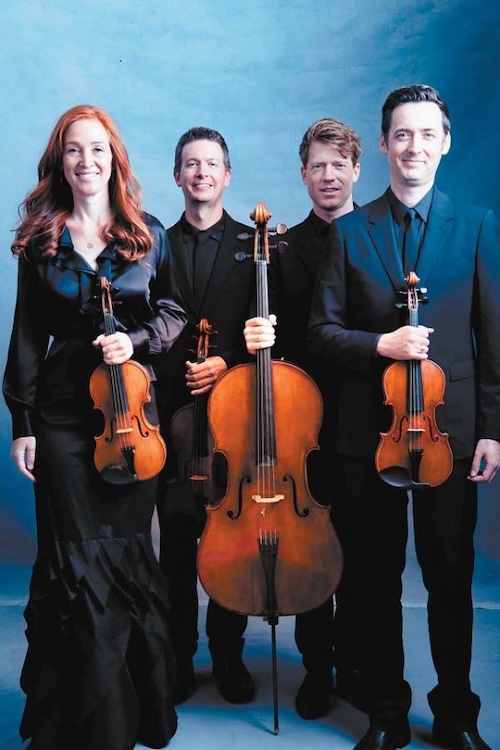Calder Quartet warms Chicago’s deep freeze with sterling concert

Northwestern University Bienen School of Music’s 27th Winter Chamber Music Festival continued its winning streak Sunday afternoon at Pick-Staiger Concert Hall with an absorbing return engagement by the Calder Quartet.
Once again the auditorium was packed with attentive listeners seemingly impervious to the single-digit temperatures and bitter winds sweeping off adjacent Lake Michigan. No more serious audience exists for chamber music in the Chicago area than the hardy band of loyalists festival director Blair Milton has cultivated over nearly three decades.
It was good to have the Los Angeles-based Calder ensemble back on the festival roster, in top form technically and musically, presenting a stylistically wide-ranging agenda that reflected a deep commitment to contemporary works that goes well beyond the dutiful obeisances of other professional chamber groups riding the circuit.
With quartets by Beethoven and Debussy serving as bookends, the program had as its centerpieces two recent pieces that are fast emerging as string-quartet classics of the early 21st century: British composer Thomas Adès’ The Four Quarters (2010), and American composer Carolyn Shaw’s Entr’acte (2011). Together, they suggested contemporary musical analogs to the famous mobiles of the quartet’s namesake, sculptor Alexander Calder.
Per its title, this second of Adès’ two string quartets suggests the passage of time at various moments of the day, albeit a “skewed” sense of time, as violist Jonathan Moerschel said in his introduction to the performance. Individually and as a whole, the four movements make one aware of a keen musical mind teeming with carefully plotted ideas—reimagining classical procedures in an imaginative, colorful manner very much his own and very much of our time. Subtle, often wryly witty references to earlier music abound (Janáček and Renaissance consort music, particularly).
The Calder’s first and second violins, Benjamin Jacobson and Tereza Stanislav, treated the bright flecks of sonority that open the first movement, “Nightfalls,” like dying embers of sunlight, over the low drone of viola and cello (Eric Byers). The scherzo-like second section, “Morning Dew,” begins as a lively, four-way conversation of plucked sounds before giving way to a grittier, more contentious colloquy of pizzicato and arco (bowed) gestures.
A pulsing repeated figure beginning in the second violin gradually fans out to the other instruments in “Days,” its rising and falling harmonic tensions evoking the inexorable flow of the hours. Askew rhythms and eerie harmonics, all in the unusual (to say the least) time signature of 25/16 bring the finale, “The 25th Hour,” to an almost hallucinatory close, the energy level gradually subsiding to quiet nocturnal murmurs. Terrific piece, terrific performance.
Delicate echoes of early music also flit through the mesmerizing pages of the Shaw piece. A four-note ostinato phrase veers between fields of consonant and dissonant harmonies, sometimes trailing off into silence, sometimes submerged by snapped pizzicatos and the breathy scuffles of bow wood against metal strings. The four-note motif ties a neat bow on the final pages, the first violinist ascending ethereally to the top of his range before the cellist strums a soft benediction.
Again, the Calder played with absolute technical precision and a musical conviction that made you hold your breath for fear of missing anything.
A superbly well-integrated account of Beethoven’s Quartet No. 3 in D Major (Op. 18, no. 3) demonstrated the Calder’s Classical bona fides in high style. The Calder’s command of dynamic contrasts and rhythmic articulation came to the fore in the outer movements, as did the spirited alacrity with which Jacobson led his colleagues through the mercurial finale.
So, too, did every musical element and interpretive gesture coalesce beautifully in the refined reading of Debussy’s Quartet in G Minor (Op. 10) that concluded the program. Here was no pallid impressionism but a Debussy of luminous textures, poised phrasing and, where needed, rhythmic bite. The second movement danced with blithe charm, set off by an Andantino of exquisite tonal purity. The ultimate effect was that of a repertory staple refreshed for modern ears.
The Winter Chamber Music Festival at Northwestern University continues with the Parker Quartet (works by Haydn, Beethoven and Grazyna Bacewicz) 7:30 p.m. Friday, and the Gryphon Trio (works by Beethoven, Schubert and Bruce Russell) 3 p.m. Jan. 21. music.northwestern.edu
Posted in Performances


